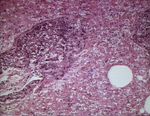Difference between revisions of "Aspiration Pneumonia"
Jump to navigation
Jump to search
(Created page with " right|thumb|150px|<small><center>Aspiration pneumonia (Image sourced from Bristol Biomed Image Archive with permission)</center></small> *Resp...") |
|||
| Line 1: | Line 1: | ||
| − | |||
[[Image:Inhalation pneumonia.jpg|right|thumb|150px|<small><center>Aspiration pneumonia (Image sourced from Bristol Biomed Image Archive with permission)</center></small>]] | [[Image:Inhalation pneumonia.jpg|right|thumb|150px|<small><center>Aspiration pneumonia (Image sourced from Bristol Biomed Image Archive with permission)</center></small>]] | ||
*Response of the lungs to aspirated foreign material will depend on the nature of the material (e.g. food), the bacterial load and the distribution of the material within the lungs | *Response of the lungs to aspirated foreign material will depend on the nature of the material (e.g. food), the bacterial load and the distribution of the material within the lungs | ||
| Line 19: | Line 18: | ||
**Most commonly [[Control of Feeding - Anatomy & Physiology#The Vomit Reflex|vomited]]/regurgitated material or contrast medium introduced into airways | **Most commonly [[Control of Feeding - Anatomy & Physiology#The Vomit Reflex|vomited]]/regurgitated material or contrast medium introduced into airways | ||
**In severe acute cases may die from septic shock | **In severe acute cases may die from septic shock | ||
| − | **In chronic cases -> [[ | + | **In chronic cases -> [[Bronchopneumonia|bronchopneumonia]] |
**Common sequel to [[Myasthenia Gravis|myasthenia gravis]], [[Megaoesophagus|megaoesophagus]] or [[Persistent Right Aortic Arch|persistent right aortic arch]] | **Common sequel to [[Myasthenia Gravis|myasthenia gravis]], [[Megaoesophagus|megaoesophagus]] or [[Persistent Right Aortic Arch|persistent right aortic arch]] | ||
[[Category:Pneumonia]] | [[Category:Pneumonia]] | ||
Latest revision as of 18:51, 19 February 2011
- Response of the lungs to aspirated foreign material will depend on the nature of the material (e.g. food), the bacterial load and the distribution of the material within the lungs
- Mild bronchopneumonia can develop into a severe necrotising pneumonia and in very severe cases can progress to gangrenous pneumonia (below)
- In Cattle
- Associated with poor husbandry
- Regurgitated ruminal content
- Cranio-ventral distribution
- Respiratory insufficiency secondary to congenital cardiac disease
- In Horses
- Most commonly in right ventral lung lobe (most rostral secondary bronchus leads to right accessory lobe)
- Risk factors:
- Oesophageal obstruction
- Spontaneous reflux (GI obstruction, equine grass sickness)
- Dysphagia
- Iatrogenic
- Nasogastric tube in the wrong place
- In Dogs
- Most commonly vomited/regurgitated material or contrast medium introduced into airways
- In severe acute cases may die from septic shock
- In chronic cases -> bronchopneumonia
- Common sequel to myasthenia gravis, megaoesophagus or persistent right aortic arch
